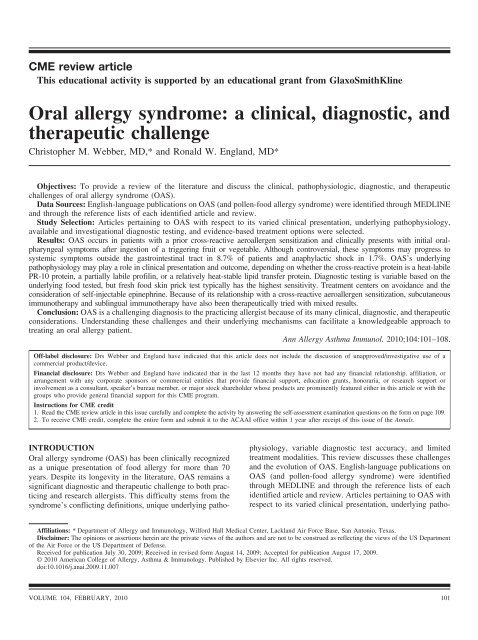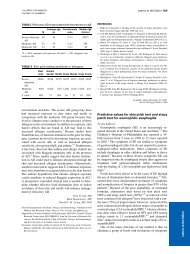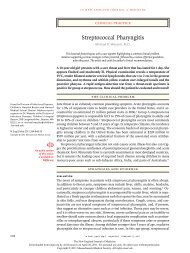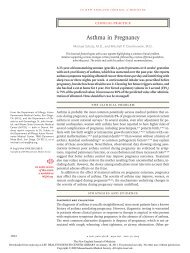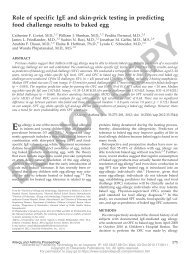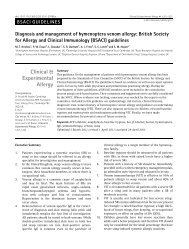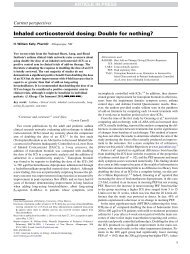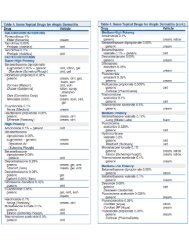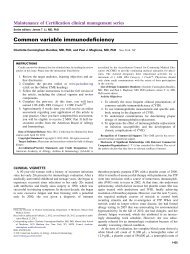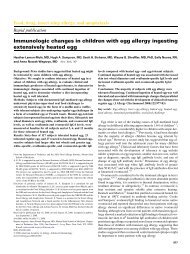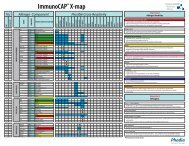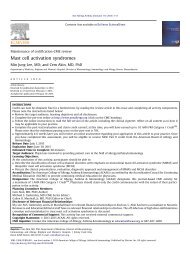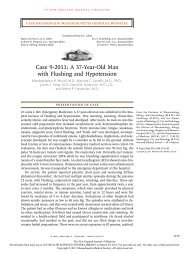Oral allergy syndrome: a clinical, diagnostic, and ... - AInotes
Oral allergy syndrome: a clinical, diagnostic, and ... - AInotes
Oral allergy syndrome: a clinical, diagnostic, and ... - AInotes
You also want an ePaper? Increase the reach of your titles
YUMPU automatically turns print PDFs into web optimized ePapers that Google loves.
CME review article<br />
This educational activity is supported by an educational grant from GlaxoSmithKline<br />
<strong>Oral</strong> <strong>allergy</strong> <strong>syndrome</strong>: a <strong>clinical</strong>, <strong>diagnostic</strong>, <strong>and</strong><br />
therapeutic challenge<br />
Christopher M. Webber, MD,* <strong>and</strong> Ronald W. Engl<strong>and</strong>, MD*<br />
Objectives: To provide a review of the literature <strong>and</strong> discuss the <strong>clinical</strong>, pathophysiologic, <strong>diagnostic</strong>, <strong>and</strong> therapeutic<br />
challenges of oral <strong>allergy</strong> <strong>syndrome</strong> (OAS).<br />
Data Sources: English-language publications on OAS (<strong>and</strong> pollen-food <strong>allergy</strong> <strong>syndrome</strong>) were identified through MEDLINE<br />
<strong>and</strong> through the reference lists of each identified article <strong>and</strong> review.<br />
Study Selection: Articles pertaining to OAS with respect to its varied <strong>clinical</strong> presentation, underlying pathophysiology,<br />
available <strong>and</strong> investigational <strong>diagnostic</strong> testing, <strong>and</strong> evidence-based treatment options were selected.<br />
Results: OAS occurs in patients with a prior cross-reactive aeroallergen sensitization <strong>and</strong> <strong>clinical</strong>ly presents with initial oralpharyngeal<br />
symptoms after ingestion of a triggering fruit or vegetable. Although controversial, these symptoms may progress to<br />
systemic symptoms outside the gastrointestinal tract in 8.7% of patients <strong>and</strong> anaphylactic shock in 1.7%. OAS’s underlying<br />
pathophysiology may play a role in <strong>clinical</strong> presentation <strong>and</strong> outcome, depending on whether the cross-reactive protein is a heat-labile<br />
PR-10 protein, a partially labile profilin, or a relatively heat-stable lipid transfer protein. Diagnostic testing is variable based on the<br />
underlying food tested, but fresh food skin prick test typically has the highest sensitivity. Treatment centers on avoidance <strong>and</strong> the<br />
consideration of self-injectable epinephrine. Because of its relationship with a cross-reactive aeroallergen sensitization, subcutaneous<br />
immunotherapy <strong>and</strong> sublingual immunotherapy have also been therapeutically tried with mixed results.<br />
Conclusion: OAS is a challenging diagnosis to the practicing allergist because of its many <strong>clinical</strong>, <strong>diagnostic</strong>, <strong>and</strong> therapeutic<br />
considerations. Underst<strong>and</strong>ing these challenges <strong>and</strong> their underlying mechanisms can facilitate a knowledgeable approach to<br />
treating an oral <strong>allergy</strong> patient.<br />
Ann Allergy Asthma Immunol. 2010;104:101–108.<br />
Off-label disclosure: Drs Webber <strong>and</strong> Engl<strong>and</strong> have indicated that this article does not include the discussion of unapproved/investigative use of a<br />
commercial product/device.<br />
Financial disclosure: Drs Webber <strong>and</strong> Engl<strong>and</strong> have indicated that in the last 12 months they have not had any financial relationship, affiliation, or<br />
arrangement with any corporate sponsors or commercial entities that provide financial support, education grants, honoraria, or research support or<br />
involvement as a consultant, speaker’s bureau member, or major stock shareholder whose products are prominently featured either in this article or with the<br />
groups who provide general financial support for this CME program.<br />
Instructions for CME credit<br />
1. Read the CME review article in this issue carefully <strong>and</strong> complete the activity by answering the self-assessment examination questions on the form on page 109.<br />
2. To receive CME credit, complete the entire form <strong>and</strong> submit it to the ACAAI office within 1 year after receipt of this issue of the Annals.<br />
INTRODUCTION<br />
<strong>Oral</strong> <strong>allergy</strong> <strong>syndrome</strong> (OAS) has been <strong>clinical</strong>ly recognized<br />
as a unique presentation of food <strong>allergy</strong> for more than 70<br />
years. Despite its longevity in the literature, OAS remains a<br />
significant <strong>diagnostic</strong> <strong>and</strong> therapeutic challenge to both practicing<br />
<strong>and</strong> research allergists. This difficulty stems from the<br />
<strong>syndrome</strong>’s conflicting definitions, unique underlying pathophysiology,<br />
variable <strong>diagnostic</strong> test accuracy, <strong>and</strong> limited<br />
treatment modalities. This review discusses these challenges<br />
<strong>and</strong> the evolution of OAS. English-language publications on<br />
OAS (<strong>and</strong> pollen-food <strong>allergy</strong> <strong>syndrome</strong>) were identified<br />
through MEDLINE <strong>and</strong> through the reference lists of each<br />
identified article <strong>and</strong> review. Articles pertaining to OAS with<br />
respect to its varied <strong>clinical</strong> presentation, underlying patho-<br />
Affiliations: * Department of Allergy <strong>and</strong> Immunology, Wilford Hall Medical Center, Lackl<strong>and</strong> Air Force Base, San Antonio, Texas.<br />
Disclaimer: The opinions or assertions herein are the private views of the authors <strong>and</strong> are not to be construed as reflecting the views of the US Department<br />
of the Air Force or the US Department of Defense.<br />
Received for publication July 30, 2009; Received in revised form August 14, 2009; Accepted for publication August 17, 2009.<br />
© 2010 American College of Allergy, Asthma & Immunology. Published by Elsevier Inc. All rights reserved.<br />
doi:10.1016/j.anai.2009.11.007<br />
VOLUME 104, FEBRUARY, 2010 101
physiology, available <strong>and</strong> investigational <strong>diagnostic</strong> testing,<br />
<strong>and</strong> evidence-based treatment options were selected.<br />
OAS has been a challenging diagnosis since the first published<br />
article in 1942 in which Tuft <strong>and</strong> Blumstein 1 discussed<br />
<strong>clinical</strong> observations of 4 adult patients who presented with<br />
itching of the soft palate <strong>and</strong> swelling of mucous membranes<br />
after eating various raw fruits. All patients reported a <strong>clinical</strong><br />
history of “hay fever” <strong>and</strong> indicated that their oral symptoms<br />
had a greater incidence during the summer months when<br />
seasonal allergies were worse. In addition, these patients<br />
reported that cooked, canned, <strong>and</strong> preserved forms did not<br />
cause symptoms. Tuft <strong>and</strong> Blumstein recognized this as a<br />
unique phase of food <strong>allergy</strong> in 1936 but had difficulty<br />
establishing its immunologic correlation. This connection<br />
came 6 years later with their inventive use of freshly extracted<br />
fruit juices in skin prick testing (SPT), which yielded<br />
positive reactions. These findings were eventually published.<br />
Interestingly, this article’s commentary revealed the publication<br />
to be more remarkable for a positive SPT result using<br />
fresh fruit extract in the setting of a previously negative test<br />
result <strong>and</strong> not for the first case presentation of OAS.<br />
Today OAS is recognized as a worldwide problem <strong>and</strong><br />
may represent the most common food <strong>allergy</strong> in adults. This<br />
speculation is largely because of its relationship with allergic<br />
rhinitis, which affects 10% to 30% of adults <strong>and</strong> up to 40% of<br />
children. 2 However, a true prevalence of OAS has yet to be<br />
determined. Early investigations described OAS prevalence<br />
based on specific fruits involved <strong>and</strong> their correlation with<br />
aeroallergens, such as the 1970 survey by Anderson et al 3 that<br />
asked 2,067 patients about symptomatic oral pruritus to either<br />
generalized or specific fruits, namely, melon <strong>and</strong> banana.<br />
Their results showed 4.3% of all patients interviewed <strong>and</strong><br />
6.2% of those with pollinosis described OAS symptoms. All<br />
these patients also demonstrated <strong>clinical</strong> <strong>and</strong> SPT reactivity to<br />
ragweed. A more comprehensive study was performed in<br />
1982 by Eriksson et al, 4 who questioned 600 adult <strong>and</strong> pediatric<br />
patients with documented allergic rhinitis (positive SPT<br />
or radioallergosorbent test [RAST] test results) regarding<br />
their tolerance of various foods. The results of this study<br />
found oral <strong>allergy</strong> symptoms in 70% of birch allergic individuals<br />
but only 20% of patients allergic to grass <strong>and</strong> mugwort.<br />
These studies remain today’s foundation for estimating<br />
OAS prevalence. However, allergists answering the 2003<br />
survey by Ma et al 5 on their management of OAS estimated<br />
the <strong>syndrome</strong>’s prevalence to be 5% in children <strong>and</strong> 8% in<br />
adult patients with nonspecific pollen allergies. In their discussion,<br />
the authors cited both physician underdiagnosis <strong>and</strong><br />
patient underreporting to explain their lower prevalence compared<br />
with earlier research. 5 There have not been any comprehensive<br />
studies specifically designed to determine a true<br />
prevalence of OAS.<br />
DEFINITION<br />
It is possible, however, that a true prevalence cannot be<br />
performed at this time because of recent controversy about<br />
the very definition of OAS. The earliest descriptive studies<br />
recognized a unique presentation of food <strong>allergy</strong> with oralpharyngeal<br />
symptoms provoked by exposure to specific food<br />
allergens. Typical symptoms are isolated to the oral-pharyngeal<br />
mucosa <strong>and</strong> commonly include itching <strong>and</strong> tingling of<br />
the lips, mouth, <strong>and</strong> throat but may also include swelling or<br />
angioedema of the tongue. 1<br />
In 1987, Amlot et al 6 published a comprehensive description<br />
of symptoms due to IgE-mediated food hypersensitivity<br />
in 80 patients with either atopic eczema or atopic reactivity to<br />
foods. In this study, Amlot et al noted one subgroup of<br />
patients in whom approximately half described only typical<br />
oral symptoms <strong>and</strong> the other half described initial oral symptoms<br />
that chronologically progressed to include gastrointestinal<br />
manifestations (nausea, vomiting, diarrhea, <strong>and</strong> abdominal<br />
pain), then urticaria or angioedema, <strong>and</strong> rarely more<br />
severe symptoms of anaphylaxis. 6 To capture this entire<br />
group’s pattern of initial oral-pharyngeal symptoms <strong>and</strong> including<br />
those with a chronologically ordered symptom progression,<br />
Amlot et al coined the actual term oral <strong>allergy</strong><br />
<strong>syndrome</strong>, which we continue to use today.<br />
During the last 15 years this definition has been challenged.<br />
Some authors contend that OAS should be strictly<br />
confined to the oral cavity <strong>and</strong> any extraoral or systemic<br />
symptoms should result in a diagnosis of food anaphylaxis. 7,8<br />
Their definition is derived from patient care scenarios in<br />
which misdiagnosis of OAS may result in inadequate treatment<br />
of potentially life-threatening food anaphylaxis. This<br />
concern is supported by the survey of Ma et al 5 on allergist’s<br />
management of OAS, which found 13% of allergists gave a<br />
misdiagnosis of OAS to a child with peanut <strong>allergy</strong> <strong>and</strong> that<br />
25% did not consider prescribing epinephrine. This survey<br />
also found that 20% of allergists applied the term OAS to a<br />
patient with systemic symptoms caused by fruit.<br />
Regardless of the final definition, today’s allergists need<br />
some form of risk evaluation to guide patient education <strong>and</strong><br />
treatment. In 1993, Ortolani et al 9 conducted a review of OAS<br />
studies to create a “summary of symptoms elicited in allergic<br />
subjects by eating fruits <strong>and</strong> vegetables.” On the basis of this<br />
review <strong>and</strong> as mathematically aggregated in the survey by Ma<br />
et al, 5 in addition to the typical oral-pharyngeal symptoms,<br />
8.7% of patients experience systemic symptoms outside the<br />
gastrointestinal tract, 3% experience systemic symptoms<br />
without oral symptoms, <strong>and</strong> 1.7% experience anaphylactic<br />
shock. Although these numbers may temporarily help guide<br />
patient care decisions, dedicated research is needed to adequately<br />
answer the incidence of symptoms outside the oral<br />
cavity <strong>and</strong> whether risk factors can be identified.<br />
IMMUNOLOGIC MECHANISM<br />
Any controversy in OAS’s definition will likely be restricted<br />
to its varied <strong>clinical</strong> presentation because the current underst<strong>and</strong>ing<br />
of OAS’s underlying pathophysiology supports the<br />
outcomes of both isolated oral symptoms <strong>and</strong> anaphylaxis.<br />
This is in part due to multiple different types of antigens<br />
capable of causing oral <strong>allergy</strong> symptoms <strong>and</strong> the unique<br />
nature of the antigens themselves. However, before these<br />
102 ANNALS OF ALLERGY, ASTHMA & IMMUNOLOGY
antigens could be identified, OAS’s relationship to pollinosis<br />
had to be established.<br />
It was not until the late 1970s, when Andersen et al used<br />
the crossed-line immunoelectrophoresis technique, that the<br />
first antigenic correlation among birch, apple, potato, <strong>and</strong><br />
hazelnut was realized. 10 After confirming an immunologic<br />
identity between birch <strong>and</strong> hazelnut, the authors also recognized<br />
a shared “affinity precipitate” between birch <strong>and</strong> both<br />
apple <strong>and</strong> potato, which they speculated might be an extremely<br />
labile allergen or possibly a plant lectin. In 1999,<br />
Kazemi-Shirazi et al 11 advanced this theory by combining<br />
multiple food <strong>and</strong> pollen antigens in quantitative RAST <strong>and</strong><br />
immunoblot inhibition assays. They identified that food specific<br />
IgE epitopes in OAS patients resembled pollen antigens.<br />
As a result they concluded that the pollen allergens themselves<br />
may be responsible for the elicitation <strong>and</strong> maintenance<br />
of oral <strong>allergy</strong> symptoms, tying together the longst<strong>and</strong>ing<br />
<strong>clinical</strong> correlation through cross-reactive allergens.<br />
Today we recognize that OAS is caused by an IgE crossreactivity<br />
between a prior aeroallergen sensitization <strong>and</strong> a<br />
characteristically difficult to extract <strong>and</strong> highly labile plantderived<br />
protein. 12 This mechanism of food <strong>allergy</strong> (now<br />
called a class 2 food <strong>allergy</strong>) is unique compared with the<br />
traditional class 1 food <strong>allergy</strong> in which the sensitization<br />
process occurs through the gastrointestinal tract from a protein<br />
allergen resistant to gastric digestion. Of the different<br />
antigen groups responsible for causing OAS, perhaps the<br />
largest <strong>and</strong> most classic group is the pathogenesis-related or<br />
pathogen response (PR) proteins.<br />
PR proteins are naturally formed in higher-order plants as<br />
responses to fungal or bacterial infections or to various<br />
stresses, such as drought, flooding, freezing temperatures,<br />
UV-B light, ozone, <strong>and</strong> mechanical injury. 13 Although biologically<br />
serving to help protect these plants against their<br />
respective environmental stimuli, in humans PR proteins become<br />
<strong>clinical</strong>ly relevant when an IgE antibody against 1 PR<br />
protein, such as an aeroallergen, cross-reacts with a similar<br />
PR protein from a different plant or food source, resulting in<br />
oral <strong>allergy</strong> symptoms. The largest group of PR proteins<br />
causing OAS comes from the PR-10 family.<br />
A key member of the PR-10 family of PR proteins is the<br />
major birch tree allergen, Betula verrucosa (Bet v) 1. Sensitization<br />
to this aeroallergen can result in cross-reactivity to<br />
homologous proteins in many foods, including members of<br />
the Rosaceae fruits (eg, apple [Mal d 1], cherry [Pru av 1],<br />
apricot [Pru ar 1], pear [Pyr c 1]), the Apiaceae vegetables<br />
(eg, carrots [Dau c 1], celery [Api g 1]), <strong>and</strong> potato (pSTH)<br />
<strong>and</strong> hazelnut (Cor a 1) (Table 1). 12 Although Bet v 1 may be<br />
a stable aeroallergen, the PR-10 (or Bet v 1–type) proteins are<br />
unstable to both heating <strong>and</strong> digestion. This feature explains<br />
early researchers’ difficulty isolating the proteins <strong>and</strong> OAS’s<br />
tendency toward oral-pharyngeal symptoms that rapidly resolve<br />
without progression to systemic symptoms because the<br />
underlying antigen is denatured <strong>and</strong> destroyed during digestion.<br />
14<br />
Although the PR-10 family of PR proteins is the largest<br />
contributor to OAS, not all patients with OAS are sensitized<br />
to birch <strong>and</strong> not all causative foods contain Bet v 1–type<br />
proteins. Attempts to reconcile this difference have resulted<br />
in the identification of additional proteins causing OAS. The<br />
PR-5 family of thaumatin-like proteins has been identified<br />
with in vitro cross-reactivity between mountain cedar’s Jun a<br />
3 allergen <strong>and</strong> cherry (Pru av 2), apple (Mal d 2), <strong>and</strong> paprika<br />
or bell pepper (P23). 13 Another cause of OAS was uncovered<br />
when Valenta et al 15 cloned <strong>and</strong> identified a novel birch<br />
antigen, Bet v 2. This antigen, however, was found in patients<br />
with <strong>and</strong> without birch <strong>allergy</strong> <strong>and</strong> led to the realization of a<br />
larger, non–PR-related protein family capable of causing oral<br />
<strong>allergy</strong> symptoms: the profilins.<br />
Profilins are 12- to 15-kDa, monomeric, actin-binding proteins<br />
found in eukaryotic cells <strong>and</strong> probably function to<br />
mediate membrane-cytoskeleton interaction. 14,16 As such,<br />
they are ubiquitous across a broad range of inhalant <strong>and</strong><br />
nutritive allergen sources, leading to cross-reactivity <strong>and</strong><br />
OAS symptoms without birch sensitization. 14 Profilin is involved<br />
in the celery-mugwort-spice <strong>syndrome</strong> <strong>and</strong> has other<br />
homologous proteins in apple, pear (Pyr c 4), carrot (Dau c<br />
4), celery (Api g 4), potato, <strong>and</strong> tomato. 12,17 Similar to PR-10<br />
proteins, profilins are generally considered to be labile <strong>and</strong><br />
easily degraded by gastric digestion, resulting in typical oral<br />
<strong>allergy</strong> symptoms. 18 However, there has been a partially<br />
heat-stabile profilin identified in a profilin-mediated systemic<br />
reaction to zucchini <strong>and</strong> a report of a profilin-mediated anaphylactic<br />
reaction to lychee fruit. 19,20<br />
Although cross-reactivity within the PR-10 or profilin families<br />
causes OAS, the lability of these proteins should limit<br />
their potential to cause systemic reactions. However, systemic<br />
reactions can occur. Addressing this discrepancy, studies<br />
analyzing OAS patients with frequent systemic symptoms<br />
revealed a novel 9- to 10-kDa OAS-causing pan-allergen: the<br />
lipid transfer protein (LTP). 21,22 LTPs function to transfer<br />
phospholipids from liposomes to mitochondria but also help<br />
plant defense as an antifungal <strong>and</strong> antibacterial agent, resulting<br />
in their current classification as the PR-14 protein family.<br />
12 Because of LTP’s 3-dimensional structure rich in -helices<br />
<strong>and</strong> cysteine residues, these proteins are stable to<br />
thermal processing <strong>and</strong> proteolysis. 14 As a result, LTPs can<br />
cause both OAS <strong>and</strong> traditional class 1 food anaphylaxis. 23,24<br />
LTPs are most often <strong>clinical</strong>ly found as pan-allergens in the<br />
Rosaceae family (eg, peach [Pru p 3], apricot [Pru ar 3],<br />
plum, <strong>and</strong> cherry) but are also found in apple (Mal d 3),<br />
tomato, carrot, barley, corn, wheat, rice, sorghum, broccoli,<br />
onion, <strong>and</strong> grapevine. 12,13,17,23,25<br />
The protein differences between the heat <strong>and</strong> proteolysis<br />
stable LTPs <strong>and</strong> the more labile PR-10 <strong>and</strong> profilin proteins<br />
can be used to explain both the subset of anaphylactic individuals<br />
according to the OAS definition of Amloet et al <strong>and</strong><br />
justification to separate OAS’s oral-pharyngeal symptoms<br />
from extraoral food anaphylaxis. 6 Ironically, these studies<br />
themselves are complicated by inclusion criteria based on<br />
differing definitions of OAS, which limits the utility of any<br />
VOLUME 104, FEBRUARY, 2010 103
Table 1. Common OAS Triggers <strong>and</strong> Related Allergens <strong>and</strong> Source<br />
Allergen <strong>and</strong> source<br />
Food<br />
Trees<br />
Grass<br />
Weeds<br />
Birch Cedar Ficus nonspecific Mugwort Ragweed Goosefoot<br />
No<br />
pollen<br />
Aniseed<br />
Unknown 17a<br />
Apple PR-10 12 PR-5 13b LTP 13<br />
Apricot PR-10 12 LTP 12<br />
Asparagus LTP 25<br />
Banana Profilin 17 Profilin 17<br />
Bell pepper<br />
PR-5 13b<br />
Broccoli<br />
Unknown 17a<br />
Cantaloupe Unknown 17a Unknown 17a<br />
Caraway seed<br />
Unknown 17a<br />
Carrot PR-10 12 Profilin 12 Profilin 17<br />
Cauliflower<br />
Unknown 17a<br />
Celery PR-10 12 Profilin 12 Profilin 12<br />
Chamomile<br />
Unknown 17a<br />
Cherry PR-10 12 PR-5 13b LTP 12<br />
Chicory PR-10 25<br />
Cori<strong>and</strong>er<br />
Unknown 17a<br />
Fennel<br />
Unknown 17a<br />
Fig Unknown 24a Unknown 25a Unknown 25a<br />
Garlic Profilin 17<br />
Hazelnut PR-10 13 LTP 25<br />
Honeydew<br />
Unknown 17a<br />
Jackfruit PR-10 25<br />
Kiwi fruit PR-5 13<br />
Leek<br />
Unknown 17a<br />
Lettuce LTP 25<br />
Lychee Profilin 19<br />
Maize<br />
LTP 13b<br />
Mango<br />
Unknown 17a<br />
Melon Profilin 17 Profilin 17<br />
Mustard Profilin 17<br />
Onion<br />
Unknown 17a<br />
Paprika PR-5 13b Unknown 17a<br />
Parsley PR-10 12 Unknown 17a<br />
Peach PR-10 13 Profilin 17 Profilin 17 LTP 12<br />
Peanut PR-10 25<br />
Pear PR-10 12<br />
Potato PR-10 12<br />
Plum PR-10 12<br />
Soybean LTP 12<br />
Tomato PR-5 13<br />
Watermelon<br />
Unknown 17a<br />
Zucchini Profilin 17<br />
Abbreviations: LTP, lipid transfer protein; OAS, oral <strong>allergy</strong> <strong>syndrome</strong>; PR, pathogen response.<br />
a<br />
Although a <strong>clinical</strong> relationship has been described, the exact protein class is not established.<br />
b<br />
In vitro sequence homology between pollen <strong>and</strong> fruit; no reported in vivo reactions.<br />
pathophysiology-based distinction of OAS’s ultimate definition.<br />
DIAGNOSIS<br />
In addition to its <strong>clinical</strong> <strong>and</strong> immunologic complexities,<br />
OAS has also been a <strong>diagnostic</strong> challenge since its initial case<br />
report, which took 6 additional years <strong>and</strong> the creation of a<br />
novel <strong>diagnostic</strong> technique to prove sensitization by skin<br />
testing. 1 Today’s <strong>diagnostic</strong> testing continues to vary in sensitivity<br />
<strong>and</strong> specificity, largely as a result of OAS’s multiple<br />
causative antigens <strong>and</strong> their potential lability. However, before<br />
reviewing individual test results, the first challenge in<br />
diagnosing OAS is to establish the “gold st<strong>and</strong>ard” of true<br />
disease.<br />
104 ANNALS OF ALLERGY, ASTHMA & IMMUNOLOGY
The double-blinded, placebo-controlled food challenge<br />
(DBPCFC) is widely accepted as the “gold st<strong>and</strong>ard” for<br />
diagnosing traditional food <strong>allergy</strong> <strong>and</strong> many would agree for<br />
diagnosing OAS as well. 26 In a study comparing OAS history<br />
to DBPCFC, Rodriguez et al 27 demonstrated that of 53 patients<br />
with a history of OAS to melon, only 25 had a positive<br />
open food challenge (OFC) result, <strong>and</strong> of those, only 17 had<br />
positive DBPCFC results. Considering these results, many<br />
<strong>diagnostic</strong> tests have been compared with DBPCFC as the<br />
st<strong>and</strong>ard to reflect true disease.<br />
However, some authors challenge this “gold st<strong>and</strong>ard,”<br />
advocating that a careful <strong>clinical</strong> history is sufficient to diagnose<br />
OAS <strong>and</strong> may better reflect true disease. 28,29 This<br />
argument is based on OAS’s unique <strong>clinical</strong> symptoms <strong>and</strong><br />
the potential that some blinding processes may not guarantee<br />
oral contact with enough provoking antigen due to OAS’s<br />
antigenic lability. 28 Supporting this idea, Anhoej et al 30 found<br />
that a good <strong>clinical</strong> history of OAS to apple had negative <strong>and</strong><br />
positive predictive values of 100% <strong>and</strong> 92% when compared<br />
with OFC, respectively. As a result, some studies compare<br />
the sensitivity <strong>and</strong> specificity of <strong>diagnostic</strong> testing using<br />
<strong>clinical</strong> history as the “gold st<strong>and</strong>ard.” Both considerations<br />
are reviewed herein.<br />
COMMERCIAL AND FRESH FRUIT SPTS<br />
When considered collectively, both the commercial SPT<br />
(CSPT) <strong>and</strong> the fresh fruit skin prick test (FFSPT) are highly<br />
variable based on the underlying food being tested (Table 2).<br />
Between the 2, many authors have debated the reliability of<br />
the CSPT, which has yielded sensitivities ranging from<br />
87.5% for potato to 0% for pear. 28 This wide variation may be<br />
due to inadvertent denaturation of the OAS antigens, particularly<br />
the PR-10 proteins, during commercial processing. 31,32<br />
Comparing CSPT with FFSPT using <strong>clinical</strong> history as a<br />
true-positive result, Ortolani et al 28 found that FFSPT yielded<br />
better sensitivity <strong>and</strong> specificity in diagnosing OAS. This<br />
observation was particularly relevant for allergens, such as<br />
apple, orange, tomato, carrot, celery, cherry, <strong>and</strong> peach. Similar<br />
results were reported by Osterballe et al 33 in birch allergic<br />
patients having OAS to apple, with FFSPT’s sensitivity ranging<br />
from 70% to 80%, which compared with a 10% sensitivity<br />
using CSPT. In another study using OFC as the “gold<br />
st<strong>and</strong>ard,” Anhoej et al 30 evaluated the <strong>diagnostic</strong> ability of<br />
FFSPT on 36 grass <strong>and</strong>/or birch allergic patients. They found<br />
FFSPT to hazelnut, apple, <strong>and</strong> melon had a sensitivity of<br />
0.97, 0.92, <strong>and</strong> 0.98 <strong>and</strong> specificities of 0.78, 0.72, <strong>and</strong> 0.82,<br />
respectively.<br />
In addition to differences among SPT methods, special<br />
consideration to the antigen being tested must also be considered<br />
in diagnosing OAS. Although most studies focused<br />
on foods related to the PR-10 protein family, Asero et al 34 in<br />
2008 skin tested 200 consecutive pollen allergic patients to<br />
date-palm profilin <strong>and</strong> found that 35% of patients were sensitized<br />
only to profilin. In another study by Asero et al, 22<br />
patients with OAS to peach without birch sensitization reacted<br />
to LTPs, which were more concentrated in the fruit’s<br />
Abbreviations: BAT, basophil activation test; CAST-ELISA, cellular antigen stimulation test in combination with enzyme-linked immunosorbent assay; CSPT, commercial skin<br />
prick test; FFSPT, fresh fruit skin prick test; NA, not available.<br />
FFSPT 82 28 65 28 12 28 93 28 67 28 73 28 100 28 42 28 75 28 61 28 41 28 80 28 62 28 50 28 100 35 NA<br />
CSPT 2 28 100 28 67 28 46 28 27 28 97 28 80 28 65 28 25 28 79 28 22 28 85 28 75 28 40 28 NA NA<br />
RAST 70 28 72 28 42 28 61 28 20 28 81 28 50 28 87 28 31 28 86 28 48 28 75 28 50 28 80 28 73 35 NA<br />
BAT (10% activation) 75 36 68 36 NA NA NA NA 85 35 85 35 NA NA 90 35 90 35 NA NA 85 35 80 35<br />
CAST-ELISA NA NA NA NA NA NA 43–86 38 77–91 38 NA NA 67–80 38 75–88 38 NA NA 71–95 38 92–67 38<br />
Sensitivity,<br />
% ficity, Speci-<br />
% tivity, Sensi-<br />
% ficity, Speci-<br />
% tivity, Sensi-<br />
% ficity, Speci-<br />
% tivity, Sensi-<br />
% ficity, Speci-<br />
% tivity, Sensi-<br />
% ficity, Speci-<br />
% tivity, Sensi-<br />
% ficity, Speci-<br />
% tivity, Sensi-<br />
% ficity, Speci-<br />
% tivity, Sensi-<br />
% ficity, Speci-<br />
%<br />
Test<br />
Apple Peanut Orange Carrot Tomato Hazelnut Pea Celery<br />
Foods tested<br />
Table 2. Comparison of Diagnostic Tests for <strong>Oral</strong> Allergy Syndrome<br />
VOLUME 104, FEBRUARY, 2010 105
skin. Considering these results, the ability to test antigens<br />
beyond the PR-10 subgroup may help explain FFSPT’s <strong>diagnostic</strong><br />
advantage over the focused antigen of CSPT. Of<br />
note, because of the ubiquitous nature of these pan-allergens,<br />
relying on profilin or LTPs alone may result in false-positive<br />
test results <strong>and</strong> an incorrect diagnosis of OAS. 16<br />
SPECIFIC IgE TESTING: IMMUNOCAP AND RAST<br />
Specific IgE testing is another method used to diagnose OAS.<br />
Similar to SPT, specific IgE testing also varies based on the<br />
underlying food. In 1988, Ortolani et al 28 directly compared<br />
SPT to Phadebas RAST in patients with a <strong>clinical</strong> history of<br />
OAS. They found the <strong>diagnostic</strong> accuracy between FFSPT<br />
<strong>and</strong> RAST was comparable for peanut, hazelnut, <strong>and</strong> pea,<br />
whereas RAST was superior in walnut. However, FFSPT<br />
remained superior for sensitivity for apple, orange, tomato,<br />
carrot, cherry, celery, <strong>and</strong> peach. A more recent study compared<br />
FFSPT with ImmunoCAP in patients with a <strong>clinical</strong><br />
history of OAS to melons. 27 Although the 95% confidence<br />
intervals between each group overlapped, this study showed<br />
the positive predictive values of FFSPT vs ImmunoCAP were<br />
comparable at 42% <strong>and</strong> 44%, respectively. The negative<br />
predictive values were 77% for FFSPT <strong>and</strong> 70% for ImmunoCAP.<br />
As with SPT, the underlying antigen being tested<br />
should be considered.<br />
BASOPHIL ACTIVATION TEST<br />
A more recent test explored for its <strong>diagnostic</strong> potential in<br />
OAS is the basophil activation test (BAT). The uniqueness of<br />
IgE-activated basophils to both secrete quantifiable bioactive<br />
mediators <strong>and</strong> to exhibit CD63 makes this a potentially useful<br />
in vitro <strong>diagnostic</strong> test. In a study of 29 patients with a<br />
<strong>clinical</strong> history of OAS <strong>and</strong> using a threshold of activated<br />
basophil counts higher than 10% of the total IgE-positive<br />
basophil population, BAT was 85% sensitive for carrots <strong>and</strong><br />
celery <strong>and</strong> 90% sensitive for hazelnut. 35 Interestingly, in this<br />
study the sensitivity of FFSPT was 100% to carrot, 100% to<br />
celery, <strong>and</strong> 90% to hazelnut. Specificities using BAT were<br />
85% to carrot, 80% to celery, <strong>and</strong> 90% to hazelnut. In a<br />
separate study of birch allergic patients with a history of OAS<br />
to apple, BAT had a sensitivity <strong>and</strong> specificity of 100%<br />
compared with healthy controls. 36 However, when comparing<br />
birch allergic patients with OAS to those without, BAT’s<br />
sensitivity <strong>and</strong> specificity decreased to 88% <strong>and</strong> 75%, respectively.<br />
A similar experiment focusing on recombinant antigens<br />
showed BAT had a sensitivity <strong>and</strong> specificity of 75%<br />
<strong>and</strong> 68% to apple, 65% <strong>and</strong> 100% to carrot, <strong>and</strong> 75% <strong>and</strong><br />
77% to celery, respectively. 37<br />
SULFIDOLEUKOTRIENE RELEASE ASSAY<br />
Another potential technique explored for the diagnosis of<br />
OAS is the sulfidoleukotriene release assay. Combining the<br />
cellular antigen stimulation test with an enzyme-linked immunosorbent<br />
assay (CAST-ELISA), Ballmer-Weber et al 38<br />
tested the value of basophil leukotriene release to diagnose<br />
OAS. In birch-sensitized patients with positive DBPCFC<br />
results, CAST-ELISA showed a sensitivity of 71% to 95%<br />
for celery, 73% to 80% for hazelnut, <strong>and</strong> 43% to 86% for<br />
carrot. Again, the comparable FFSPT sensitivities to celery,<br />
hazelnut, <strong>and</strong> carrot were 100%, 80%, <strong>and</strong> 100%, respectively.<br />
However, CAST-ELISA had higher specificities for<br />
OAS than CAP-FEIA IgE testing, resulting in a higher positive<br />
predictive value.<br />
TREATMENT<br />
As discussed in the Practice Parameters, the treatment of food<br />
<strong>allergy</strong> is avoidance, education, <strong>and</strong> emergency management<br />
with injectable epinephrine. 26 Although different from a traditional<br />
class 1 food <strong>allergy</strong>, OAS remains a food <strong>allergy</strong> <strong>and</strong><br />
the same basic tenets of treatment may apply. However, there<br />
are 2 potential pitfalls specific to the treatment of OAS. First,<br />
there is the potential for an improper diagnosis of OAS in a<br />
patient with food anaphylaxis. The survey of Ma et al revealed<br />
20% of allergists classified a systemic reaction to<br />
peach as OAS, whereas another 25% did not prescribe epinephrine<br />
for a systemic peach <strong>allergy</strong> manifested by initial<br />
oral-pharyngeal symptoms. 5 Second, there is the potential to<br />
dismiss the properly selected oral <strong>allergy</strong> patient as having no<br />
risk of anaphylaxis. Although this is currently a debated topic<br />
in the literature, until a comprehensive evidence-based definition<br />
of OAS can be determined, the survey of Ma et al<br />
suggests that 8.7% of OAS patients experienced systemic<br />
symptoms outside the gastrointestinal tract <strong>and</strong> 1.7% experienced<br />
anaphylactic shock. 5 For these possibilities, Ma et al<br />
report that 3% of practicing allergists will always give selfinjectable<br />
epinephrine to an OAS patient, 67% prescribe<br />
epinephrine on a case-by-case basis, <strong>and</strong> 30% never prescribe<br />
epinephrine. 5 Although there is currently no therapeutic consensus,<br />
recognizing the potential pitfalls in treatment can help<br />
individualize the recommendations of avoidance, education,<br />
<strong>and</strong> emergency management to oral <strong>allergy</strong> patients.<br />
In the traditional type 1 food allergic patient, trigger avoidance<br />
<strong>and</strong> the use of self-injectable epinephrine for reactions to<br />
unintentional exposure remain the st<strong>and</strong>ard therapy. However,<br />
because OAS is believed to be initiated by a primary<br />
aeroallergen sensitization, the role of immunotherapy has<br />
been reexamined as a potential therapy specific to OAS.<br />
Starting with the early positive case report of fresh fruit<br />
tolerance after a year of pollen immunotherapy reported by<br />
Kelso et al, 39 multiple studies have examined the effects of<br />
subcutaneous immunotherapy (SCIT) <strong>and</strong> sublingual immunotherapy<br />
(SLIT) on OAS. The results have been mixed.<br />
In 1995, Hermann et al 40 surveyed 20 patients with birchpollen<br />
<strong>allergy</strong> during 2 to 3 years of SCIT <strong>and</strong> showed that in<br />
9 of 20 (45%) oral <strong>allergy</strong> symptoms improved, although the<br />
duration of this effect was limited. In 1998, Asero et al 41<br />
prospectively followed up 49 birch-sensitive patients with<br />
OAS to apple after receiving 1 to 3 years of birch SCIT.<br />
When compared with controls, 41 of 49 (84%) reported<br />
subjective improvement in OAS symptoms. Of these, 19 of<br />
41 (46%) showed a 50% to 95% improvement <strong>and</strong> 22 of 41<br />
(54%) showed complete disappearance of OAS symptoms. In<br />
106 ANNALS OF ALLERGY, ASTHMA & IMMUNOLOGY
a separate study by the same author, a single patient with<br />
OAS to fennel <strong>and</strong> cucumber <strong>and</strong> laryngeal edema to melon<br />
was initiated on SCIT to grass, mugwort, <strong>and</strong> ragweed pollen.<br />
42 After 36 months of immunotherapy, the patient tolerated<br />
an open challenge to fennel <strong>and</strong> cucumber without<br />
experiencing any symptoms, <strong>and</strong> after 43 months of SCIT she<br />
underwent an open challenge to melon without any consequence.<br />
Additional studies have demonstrated an improvement in<br />
apple tolerance after SCIT through pretreatment <strong>and</strong> posttreatment<br />
food challenges. Bolhaar et al 43 showed that 9 of 13<br />
patients (69%) had improved OAS visual analog scores after<br />
12 months of SCIT <strong>and</strong> 3 of 9 (33%) had complete symptom<br />
resolution based on DBPCFC. A later study by Bucher et al 44<br />
compared pretreatment <strong>and</strong> posttreatment OFCs on patients<br />
with OAS to apple <strong>and</strong> hazelnut after a 12-month course of<br />
birch-inclusive SCIT. At the conclusion of the study period,<br />
13 of 15 patients (87%) could eat more apples or hazelnuts<br />
before provoking <strong>clinical</strong> symptoms, with the tolerated quantity<br />
of apple increasing from 12.6 to 32.6 g. Although this<br />
represented a statistically significant increase, the authors<br />
noted the potentially limited <strong>clinical</strong> relevance to the patient’s<br />
management. 44<br />
Overall, these studies demonstrated some potential desensitization<br />
during active pollen immunotherapy in OAS. However,<br />
1 study suggested questionable long-term benefit. Specifically<br />
addressing this concern, Asero 45 published a<br />
follow-up study on the duration of birch immunotherapy’s<br />
effect in conferring apple tolerance. Of the initial study<br />
population, 27 of 30 patients (90%) remained apple tolerant 6<br />
months after completing SCIT. This number decreased to<br />
only 11 of 30 patients (34%) remaining symptom free after 30<br />
months <strong>and</strong> progressively decreased such that of the 3 patients<br />
attending the 42-month follow-up, only 2 of 30 (0.07%)<br />
remained apple tolerant. As a potential explanation for<br />
SCIT’s variability to induce OAS tolerance, the same author<br />
published an editorial that suggested that higher antigen<br />
quantities may be required to induce an appreciable effect on<br />
OAS compared with those needed for pollen-related symptoms.<br />
46<br />
As an alternative approach to SCIT, some authors have<br />
evaluated the effectiveness of pollen-specific SLIT in modifying<br />
oral <strong>allergy</strong> symptoms. Kinaciyan et al 47 evaluated 15<br />
patients with apple OAS undergoing birch-pollen SLIT <strong>and</strong><br />
demonstrated no significant change in OAS tolerance, despite<br />
9 of 15 patients (60%) reporting subjective improvement in<br />
nasal provocation to aeroallergens. Two larger studies also<br />
examined SLIT but did so as a comparison among SLIT,<br />
SCIT, <strong>and</strong> placebo. Möller 48 enrolled 72 children with birch<br />
allergies <strong>and</strong> typical OAS symptoms to receive SCIT (n <br />
42), SLIT (n 14), <strong>and</strong> placebo (n 16) <strong>and</strong> found that<br />
neither the SCIT nor SLIT group had significantly improved<br />
food sensitivity over placebo. A recent study by Hansen et<br />
al 49 enrolled 74 birch allergic patients into a double-blind,<br />
double-dummy, placebo-controlled comparison between 2<br />
years of SCIT <strong>and</strong> SLIT. Comparing pretreatment OFCs <strong>and</strong><br />
posttreatment OFCs in a subgroup of 51 patients with OAS<br />
symptoms to apple, the authors noted a trend toward a decrease<br />
in <strong>clinical</strong> reactivity to plant foods in all groups,<br />
including placebo. As a result, neither SCIT nor SLIT significantly<br />
affected apple tolerance.<br />
CONCLUSIONS<br />
Since the first case report, OAS has been a challenging<br />
diagnosis to the practicing allergist because of its many<br />
<strong>clinical</strong>, <strong>diagnostic</strong>, <strong>and</strong> therapeutic considerations. Although<br />
these challenges may frustrate some, they also indicate a<br />
diagnosis that is actively being shaped <strong>and</strong> structured in the<br />
literature today. Despite its initially slow start more than 70<br />
years ago, OAS will remain an interesting topic for many<br />
years to come.<br />
REFERENCES<br />
1. Tuft L, Blumstein G. Studies in food <strong>allergy</strong>—sensitization to fresh<br />
fruits: <strong>clinical</strong> <strong>and</strong> experimental observations. J Allergy. 1942;13:<br />
574–578.<br />
2. Wallace DV, Dykewicz MS, Bernstein DI, et al. The diagnosis <strong>and</strong><br />
management of rhinitis: an updated practice parameter. J Allergy Clin<br />
Immunol. 2008;122(suppl):S1–S84.<br />
3. Anderson LB Jr, Dreyfuss EM, Logan J, Johnstone DE, Glaser J. Melon<br />
<strong>and</strong> banana sensitivity coincident with ragweed pollinosis. J Allergy.<br />
1970;45:310–319.<br />
4. Eriksson NE, Formgren H, Svenonius E. Food hypersensitivity in patients<br />
with pollen <strong>allergy</strong>. Allergy. 1982;37:437–443.<br />
5. Ma S, Sicherer SH, Nowak-Wegrzyn A. A survey on the management of<br />
pollen-food <strong>allergy</strong> <strong>syndrome</strong> in <strong>allergy</strong> practices. J Allergy Clin Immunol.<br />
2003;112:784–788.<br />
6. Amlot PL, Kemeny DM, Zachary C, Parkes P, Lessof MH. <strong>Oral</strong> <strong>allergy</strong><br />
<strong>syndrome</strong> (OAS): symptoms of IgE-mediated hypersensitivity to foods.<br />
Clin Allergy. 1987;17:33–42.<br />
7. Detjen P. <strong>Oral</strong> <strong>allergy</strong> <strong>syndrome</strong> or anaphylaxis? Ann Allergy Asthma<br />
Immunol. 1996;77:254.<br />
8. Kelso JM. <strong>Oral</strong> <strong>allergy</strong> <strong>syndrome</strong>? J Allergy Clin Immunol. 1995;96:275.<br />
9. Ortolani C, Pastorello EA, Farioli L, et al. IgE-mediated <strong>allergy</strong> from<br />
vegetable allergens. Ann Allergy. 1993;71:470–476.<br />
10. Andersen KE, Lowenstein H. An investigation of the possible immunological<br />
relationship between allergen extracts from birch pollen, hazelnut,<br />
potato <strong>and</strong> apple. Contact Dermatitis. 1978;4:73–79.<br />
11. Kazemi-Shirazi L, Pauli G, Purohit A, et al. Quantitative IgE inhibition<br />
experiments with purified recombinant allergens indicate pollen-derived<br />
allergens as the sensitizing agents responsible for many forms of plant<br />
food <strong>allergy</strong>. J Allergy Clin Immunol. 2000;105:116–125.<br />
12. Breiteneder H, Ebner C. Molecular <strong>and</strong> biochemical classification of<br />
plant-derived food allergens. J Allergy Clin Immunol. 2000;106:27–36.<br />
13. Midoro-Horiuti T, Brooks EG, Goldblum RM. Pathogenesis-related<br />
proteins of plants as allergens. Ann Allergy Asthma Immunol. 2001;87:<br />
261–271.<br />
14. Breiteneder H, Clare Mills EN. Plant food allergens–structural <strong>and</strong><br />
functional aspects of allergenicity. Biotechnol Adv. 2005;23:395–399.<br />
15. Valenta R, Duchene M, Ebner C, et al. Profilins constitute a novel family<br />
of functional plant pan-allergens. J Exp Med. 1992;175:377–385.<br />
16. Ebo DG, Hagendorens MM, Bridts CH, De Clerck LS, Stevens WJ.<br />
Sensitization to cross-reactive carbohydrate determinants <strong>and</strong> the ubiquitous<br />
protein profilin: mimickers of <strong>allergy</strong>. Clin Exp Allergy. 2004;<br />
34:137–144.<br />
17. Egger M, Mutschlechner S, Wopfner N, Gadermaier G, Briza P, Ferreira<br />
F. Pollen-food <strong>syndrome</strong>s associated with weed pollinosis: an update<br />
from the molecular point of view. Allergy. 2006;61:461–476.<br />
18. Lucas JS, Cochrane SA, Warner JO, Hourihane JO. The effect of<br />
digestion <strong>and</strong> pH on the allergenicity of kiwifruit proteins. Pediatr<br />
Allergy Immunol. 2008;19:392–398.<br />
VOLUME 104, FEBRUARY, 2010 107
19. Reindl J, Anliker MD, Karamloo F, Vieths S, Wuthrich B. Allergy<br />
caused by ingestion of zucchini (Cucurbita pepo): characterization of<br />
allergens <strong>and</strong> cross-reactivity to pollen <strong>and</strong> other foods. J Allergy Clin<br />
Immunol. 2000;106:379–385.<br />
20. Fah J, Wuthrich B, Vieths S. Anaphylactic reaction to lychee fruit:<br />
evidence for sensitization to profilin. Clin Exp Allergy. 1995;25:<br />
1018–1023.<br />
21. Pastorello EA, Farioli L, Pravettoni V, et al. The major allergen of peach<br />
(Prunus persica) is a lipid transfer protein. J Allergy Clin Immunol.<br />
1999;103:520–526.<br />
22. Asero R, Mistrello G, Roncarolo D, Casarini M, Falagiani P. Allergy to<br />
nonspecific lipid transfer proteins in Rosaceae: a comparative study of<br />
different in vivo <strong>diagnostic</strong> methods. Ann Allergy Asthma Immunol.<br />
2001;87:68–71.<br />
23. Asero R, Mistrello G, Roncarolo D, et al. Lipid transfer protein: a<br />
pan-allergen in plant-derived foods that is highly resistant to pepsin<br />
digestion. Int Arch Allergy Immunol. 2001;124:67–69.<br />
24. Gamboa PM, Caceres O, Antepara I, et al. Two different profiles of<br />
peach <strong>allergy</strong> in the north of Spain. Allergy. 2007;62:408–414.<br />
25. Mari A, Ballmer-Weber BK, Vieths S. The oral <strong>allergy</strong> <strong>syndrome</strong>:<br />
improved <strong>diagnostic</strong> <strong>and</strong> treatment methods. Curr Opin Allergy Clin<br />
Immunol. 2005;5:267–273.<br />
26. Food <strong>allergy</strong>: a practice parameter. Ann Allergy Asthma Immunol. 2006;<br />
96(suppl):S1–S68.<br />
27. Rodriguez J, Crespo JF, Burks W, et al. R<strong>and</strong>omized, double-blind,<br />
crossover challenge study in 53 subjects reporting adverse reactions to<br />
melon (Cucumis melo). J Allergy Clin Immunol. 2000;106:968–972.<br />
28. Ortolani C, Ispano M, Pastorello EA, Ansaloni R, Magri GC. Comparison<br />
of results of skin prick tests (with fresh foods <strong>and</strong> commercial food<br />
extracts) <strong>and</strong> RAST in 100 patients with oral <strong>allergy</strong> <strong>syndrome</strong>. J Allergy<br />
Clin Immunol. 1989;83:683–690.<br />
29. Cadot P, Kochuyt AM, van Ree R, Ceuppens JL. <strong>Oral</strong> <strong>allergy</strong> <strong>syndrome</strong><br />
to chicory associated with birch pollen <strong>allergy</strong>. Int Arch Allergy Immunol.<br />
2003;131:19–24.<br />
30. Anhoej C, Backer V, Nolte H. Diagnostic evaluation of grass- <strong>and</strong><br />
birch-allergic patients with oral <strong>allergy</strong> <strong>syndrome</strong>. Allergy. 2001;56:<br />
548–552.<br />
31. Bjorksten F, Halmepuro L, Hannuksela M, Lahti A. Extraction <strong>and</strong><br />
properties of apple allergens. Allergy. 1980;35:671–677.<br />
32. Rudeschko O, Fahlbusch B, Henzgen M, et al. Investigation of the<br />
stability of apple allergen extracts. Allergy. 1995;50:575–580.<br />
33. Osterballe M, Scheller R, Stahl Skov P, Andersen KE, Bindslev-Jensen<br />
C. Diagnostic value of scratch-chamber test, skin prick test, histamine<br />
release <strong>and</strong> specific IgE in birch-allergic patients with oral <strong>allergy</strong><br />
<strong>syndrome</strong> to apple. Allergy. 2003;58:950–953.<br />
34. Asero R, Monsalve R, Barber D. Profilin sensitization detected in the<br />
office by skin prick test: a study of prevalence <strong>and</strong> <strong>clinical</strong> relevance of<br />
profilin as a plant food allergen. Clin Exp Allergy. 2008;38:1033–1037.<br />
35. Erdmann SM, Heussen N, Moll-Slodowy S, Merk HF, Sachs B. CD63<br />
expression on basophils as a tool for the diagnosis of pollen-associated<br />
food <strong>allergy</strong>: sensitivity <strong>and</strong> specificity. Clin Exp Allergy. 2003;33:<br />
607–614.<br />
36. Ebo DG, Hagendorens MM, Bridts CH, Schuerwegh AJ, De Clerck LS,<br />
Stevens WJ. Flow cytometric analysis of in vitro activated basophils,<br />
specific IgE <strong>and</strong> skin tests in the diagnosis of pollen-associated food<br />
<strong>allergy</strong>. Cytometry B Clin Cytom. 2005;64:28–33.<br />
37. Erdmann SM, Sachs B, Schmidt A, et al. In vitro analysis of birchpollen-associated<br />
food <strong>allergy</strong> by use of recombinant allergens in the<br />
basophil activation test. Int Arch Allergy Immunol. 2005;136:230–238.<br />
38. Ballmer-Weber BK, Weber JM, Vieths S, Wuthrich B. Predictive value<br />
of the sulfidoleukotriene release assay in oral <strong>allergy</strong> <strong>syndrome</strong> to celery,<br />
hazelnut, <strong>and</strong> carrot. J Investig Allergol Clin Immunol. 2008;18:93–99.<br />
39. Kelso JM, Jones RT, Tellez R, Yunginger JW. <strong>Oral</strong> <strong>allergy</strong> <strong>syndrome</strong><br />
successfully treated with pollen immunotherapy. Ann Allergy Asthma<br />
Immunol. 1995;74:391–396.<br />
40. Herrmann D, Henzgen M, Frank E, Rudeschko O, Jager L. Effect of<br />
hyposensitization for tree pollinosis on associated apple <strong>allergy</strong>. J Investig<br />
Allergol Clin Immunol. 1995;5:259–267.<br />
41. Asero R. Effects of birch pollen-specific immunotherapy on apple <strong>allergy</strong><br />
in birch pollen-hypersensitive patients. Clin Exp Allergy. 1998;28:<br />
1368–1373.<br />
42. Asero R. Fennel, cucumber, <strong>and</strong> melon <strong>allergy</strong> successfully treated with<br />
pollen-specific injection immunotherapy. Ann Allergy Asthma Immunol.<br />
2000;84:460–462.<br />
43. Bolhaar ST, Tiemessen MM, Zuidmeer L, et al. Efficacy of birch-pollen<br />
immunotherapy on cross-reactive food <strong>allergy</strong> confirmed by skin tests<br />
<strong>and</strong> double-blind food challenges. Clin Exp Allergy. 2004;34:761–769.<br />
44. Bucher X, Pichler WJ, Dahinden CA, Helbling A. Effect of tree pollen<br />
specific, subcutaneous immunotherapy on the oral <strong>allergy</strong> <strong>syndrome</strong> to<br />
apple <strong>and</strong> hazelnut. Allergy. 2004;59:1272–1276.<br />
45. Asero R. How long does the effect of birch pollen injection SIT on apple<br />
<strong>allergy</strong> last? Allergy. 2003;58:435–438.<br />
46. Asero R. Effects of birch pollen SIT on apple <strong>allergy</strong>: a matter of<br />
dosage? Allergy. 2004;59:1269–1271.<br />
47. Kinaciyan T, Jahn-Schmid B, Radakovics A, et al. Successful sublingual<br />
immunotherapy with birch pollen has limited effects on concomitant<br />
food <strong>allergy</strong> to apple <strong>and</strong> the immune response to the Bet v 1 homolog<br />
Mal d 1. J Allergy Clin Immunol. 2007;119:937–943.<br />
48. Möller C. Effect of pollen immunotherapy on food hypersensitivity in<br />
children with birch pollinosis. Ann Allergy. 1989;62:343–345.<br />
49. Hansen KS, Khinchi MS, Skov PS, Bindslev-Jensen C, Poulsen LK,<br />
Malling HJ. Food <strong>allergy</strong> to apple <strong>and</strong> specific immunotherapy with<br />
birch pollen. Mol Nutr Food Res. 2004;48:441–448.<br />
Requests for reprints should be addressed to:<br />
Christopher M. Webber, MD<br />
Department of Allergy <strong>and</strong> Immunology<br />
Wilford Hall Medical Center<br />
2200 Bergquist Dr<br />
Suite 1<br />
Lackl<strong>and</strong> Air Force Base<br />
San Antonio, TX 78236<br />
E-mail: Christopher.M.Webber@gmail.com<br />
108 ANNALS OF ALLERGY, ASTHMA & IMMUNOLOGY


